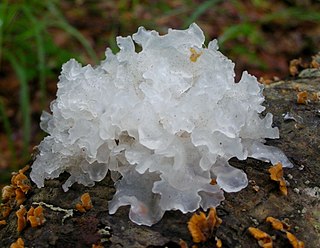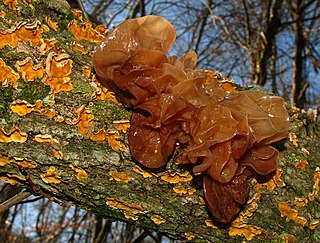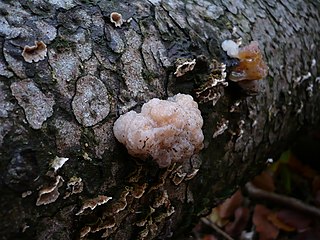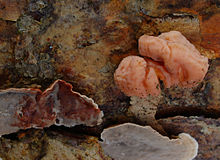
Tremella fuciformis is a species of fungus; it produces white, frond-like, gelatinous basidiocarps. It is widespread, especially in the tropics, where it can be found on the dead branches of broadleaf trees. This fungus is commercially cultivated and is one of the most popular fungi in the cuisine and medicine of China. T. fuciformis is commonly known as snow fungus, snow ear, silver ear fungus, white jelly mushroom, and white cloud ears.

Phaeotremella frondosa is a species of fungus in the family Phaeotremellaceae producing brownish, frondose, gelatinous basidiocarps. It is widespread in north temperate regions, and is parasitic on other species of fungi that grow on dead attached and recently fallen branches of broadleaf trees.

Phaeotremella foliacea is a species of fungus in the family Phaeotremellaceae. It produces brownish, frondose, gelatinous basidiocarps and is parasitic on the mycelium of Stereum sanguinolentum, a fungus that grows on dead attached and recently fallen branches of conifers. It is widespread in north temperate regions. In the UK it has the recommended English name leafy brain and has also been called jelly leaf and brown witch's butter. Prior to 2017, the name Tremella foliacea was also applied to similar-looking species on broadleaf trees, now distinguished as Phaeotremella frondosa and Phaeotremella fimbriata.

Naematelia is a genus of fungi in the family Naemateliaceae. All Naematelia species are parasites of other fungi and produce anamorphic yeast states. When produced, Basidiocarps ,, are gelatinous and are colloquially classed among the "jelly fungi."Four species of Naematelia are currently recognized worldwide. One species, Naematelia aurantialba, is commercially cultivated for food.

Naematelia aurantia is a species of fungus producing yellow, frondose, gelatinous basidiocarps. It is widespread in north temperate regions and is parasitic on another species of fungus that grows on dead attached and recently fallen branches of broadleaf trees. It is commonly called golden ear in North America.
Phaeotremella fimbriata is a species of fungus in the family Phaeotremellaceae. It produces blackish, frondose, gelatinous basidiocarps and is parasitic on the mycelium of Stereum rugosum, a fungus that grows on dead attached and recently fallen branches of broad-leaved trees. It is widespread in northern Europe. Prior to 2017, the species was generally considered a synonym of Tremella foliacea, but this latter species is restricted to conifers. Phaeotremella frondosa is a similar-looking but paler, brown species on broad-leaved trees and occurs in North America as well as Europe.
Phaeotremella roseotincta is a species of fungus in the family Phaeotremellaceae. It produces pinkish to pale pinkish brown, frondose, gelatinous basidiocarps and grows on dead attached and recently fallen branches of broad-leaved trees. It was originally described from Japan and has also been recorded from far eastern Russia.
Phaeotremella eugeniae is a species of fungus in the family Phaeotremellaceae. It produces blackish brown, frondose, gelatinous basidiocarps and grows on dead attached and recently fallen branches of oak. It was originally described from far eastern Russia and named after Russian mycologist Eugenia Bulakh.

Phaeotremella mycophaga is a species of fungus in the family Phaeotremellaceae. It produces small, pustular, gelatinous basidiocarps on the hymenium of the corticioid fungi Aleurodiscus amorphus and A. grantii on conifers.
Tremella dysenterica is a species of fungus in the family Tremellaceae. It produces bright yellow, red-spotted, lobed to subfrondose, gelatinous basidiocarps and is parasitic on other fungi on dead branches of broad-leaved trees. It was originally described from Brazil and has been recorded elsewhere in the neotropics and in Africa.
Tremella fibulifera is a species of fungus in the family Tremellaceae. It produces soft, whitish, lobed to frondose, gelatinous basidiocarps and is parasitic on other fungi on dead branches of broad-leaved trees. It was originally described from Brazil.

Tremella vesiculosa is a species of fungus in the family Tremellaceae. It produces light brown, lobed, gelatinous basidiocarps and is parasitic on other fungi on dead branches of broad-leaved trees. It was originally described from New Zealand.
Tremella samoensis is a species of fungus in the family Tremellaceae. It produces red to orange-yellow, lobed to firmly foliaceous, gelatinous basidiocarps and is parasitic on other fungi on dead branches of broad-leaved trees. It was originally described from Samoa and the Philippines, but is widely distributed in the region.
Tremella brasiliensis is a species of fungus in the family Tremellaceae. It produces yellow, lobed to firmly foliaceous, gelatinous basidiocarps and is parasitic on other fungi on dead branches of broad-leaved trees. It was originally described from Brazil.
Tremella roseolutescens is a species of fungus in the family Tremellaceae. It produces rose-pink to salmon, pustular, gelatinous basidiocarps and is parasitic on other fungi on dead attached branches of broad-leaved trees. It was originally described from Costa Rica.
Tremella armeniaca is a species of fungus in the family Tremellaceae. It produces orange to apricot, lobed, gelatinous basidiocarps and is parasitic on other fungi on dead branches of broad-leaved trees. It was originally described from Costa Rica.
Tremella versicolor is a species of fungus in the family Tremellaceae. It produces small, pustular, gelatinous basidiocarps and is parasitic on the basidiocarps of Peniophora species, a genus of corticioid fungi, on dead attached or recently fallen branches. It was originally described from England.
Tremella exigua is a species of fungus in the family Tremellaceae. It produces small, dark, pustular, gelatinous basidiocarps and is parasitic on pyrenomycetous fungi on dead branches of trees and shrubs. It was originally described from France.
Tremella mesenterella is a species of fungus in the family Tremellaceae. It produces yellowish to reddish brown, foliose, gelatinous basidiocarps and is parasitic on corticioid fungi on dead branches of broadleaf trees and shrubs. It was originally described from Canada.
Phaeotremella translucens is a species of fungus in the family Phaeotremellaceae. It produces small, pustular, gelatinous basidiocarps and is parasitic on ascocarps of Lophodermium species on decaying pine needles. It was originally described from Scotland.









